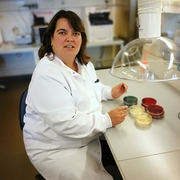- Level Foundation
- Duration 7 hours
- Course by Technical University of Denmark (DTU)
-
Offered by

About
This course will cover the topic of Whole genome sequencing (WGS) of bacterial genomes which is becoming more and more relevant for the medical sector. WGS technology and applications are high on international political agenda, as the classical methods are being replaced by WGS technology and therefore bioinformatic tools are extremely important for allowing the people working in this sector to be able to analyze the data and obtain results that can be interpreted and used for different purposes. The course will give the learners a basis to understand and be acquainted with WGS applications in surveillance of bacteria including species identification, typing and characterization of antimicrobial resistance and virulence traits as well as plasmid characterization. It will also give the opportunity to learners to learn about online tools and what they can be used for through demonstrations on how to use some of these tools and exercises to be solved by learners with use of freely available WGS analysis tools . By the end of this course you should be able to: 1. Describe the general Principles in typing of Bacteria 2. Give examples of the applications of Whole Genome Sequencing to Surveillance of bacterial pathogens and antimicrobial resistance 3. Apply genomic tools for sub-typing and surveillance 4. Define the concept of Next-Generation Sequencing and describe the sequencing data from NGS 5. Describe how to do de novo assembly from raw reads to contigs 6. Enumerate the methods behind the tools for species identification, MLST typing and resistance gene detection 7. Apply the tools for species identification, MLST typing and resistance gene detection in real cases of other bacterial and pathogen genomes. 8. Describe the methods behind the tools for Salmonella and E.coli typing, plasmid replicon detection and plasmid typing 9. Utilize the tools for Salmonella and E.coli typing, plasmid replicon detection and plasmid typing in real cases of other bacterial and pathogen genomes. 10. Explain the concept and be able to use the integrated bacterial analysis pipeline for batch analysis and typing of genomic data 11. Demonstrate how to construct phylogenetic tree based on SNPs 12. Apply the phylogenetic tool to construct phylogenetic trees and explain the relatedness of bacterial or pathogen strains 13. Describe how to create your own sequence database 14. Utilize the MyDbFinder tool to detect genetic markers of interest from whole genome sequencingModules
Welcome
1
Videos
- Welcome lecture
Introduction to bacterial sub-typing and surveillance
1
Assignment
- Module 1
1
Discussions
- You own thoughts on applications for WGS
2
Videos
- General Principles of typing of bacteria
- Surveillance of Antimicrobial Resistance using whole genome sequencing
Introduction to Next generation sequencing (NGS)
1
Assignment
- Module 2
3
Videos
- Application of Genomic tools- One technology takes it all
- Introduction to Next-Generation sequencing (NGS)
- De novo assembly- from raw reads to contigs: assembler tool description and application
NGS Tools for Species, MLST and Resistance Genes Identification
1
Assignment
- Module 3
3
Videos
- Species identification: KmerFinder tool description and applications
- MLST Typing: MLST tool description and applications
- Resistance gene detection: Resfinder tool description and applications
NGS Tools for serotyping and plasmid Identification
1
Assignment
- Module 4
4
Videos
- Salmonella Serotype identification: SeqSero tool description and applications
- E. coli serotype identification: serotype finder tool description and applications
- Plasmid replicon identification and plasmid typing
- Mobile Element Finder: A web-based tool for detection of Mobile Genetic Elements in assembled sequences
NGS Tools For Bacterial Analysis Pipeline, Phylogeny and build your own database
1
Assignment
- Module 5
3
Videos
- Phylogenetic relatedness: CSI Phylogeny tool description and applications
- Evergreen Tree: A platform for identification of foodborne bacterial outbreaks
- Multipurpose detection of genetic markers- My Db finder tool description and applications
Exercise: Solve the outbreak investigation!!!
1
Assignment
- Tutorial final Quiz
1
Videos
- Tutorial
1
Readings
- Text with Link to files to be used in tutorial
Final remarks and conclusion of the course
1
Videos
- Final Remarks and perspectives
Auto Summary
Unlock the future of bacterial research with our comprehensive course on Whole Genome Sequencing (WGS) of bacterial genomes, tailored for the Science & Engineering domain. Led by Coursera, this foundational course delves into the transformative impact of WGS technology in the medical sector, replacing traditional methods and emphasizing the importance of bioinformatics. Throughout the course, you'll explore the vital applications of WGS, including bacterial surveillance, species identification, and characterization of antimicrobial resistance and virulence traits. Engage with practical demonstrations and exercises using freely available online tools to enhance your analytical skills. Key learning outcomes include: - Understanding the principles of bacterial typing - Applying WGS in pathogen surveillance and resistance detection - Mastering genomic tools for sub-typing and surveillance - Conducting de novo assembly from raw reads to contigs - Utilizing tools for species identification, MLST typing, and resistance gene detection - Typing Salmonella and E.coli, detecting plasmid replicons, and constructing phylogenetic trees - Creating and managing your own sequence database with MyDbFinder With a total duration of 420 hours, this course offers flexible subscription options, including Starter and Professional plans, making it accessible to all learners eager to advance their expertise in bacterial genome sequencing. Ideal for professionals in the medical and bioinformatics fields, this course equips you with the knowledge and tools to interpret and utilize WGS data effectively, ensuring you stay at the forefront of bacterial research and surveillance. Join us and transform your understanding of bacterial genomics today!

Lina Cavaco

Pimlapas Leekitcharoenphon


